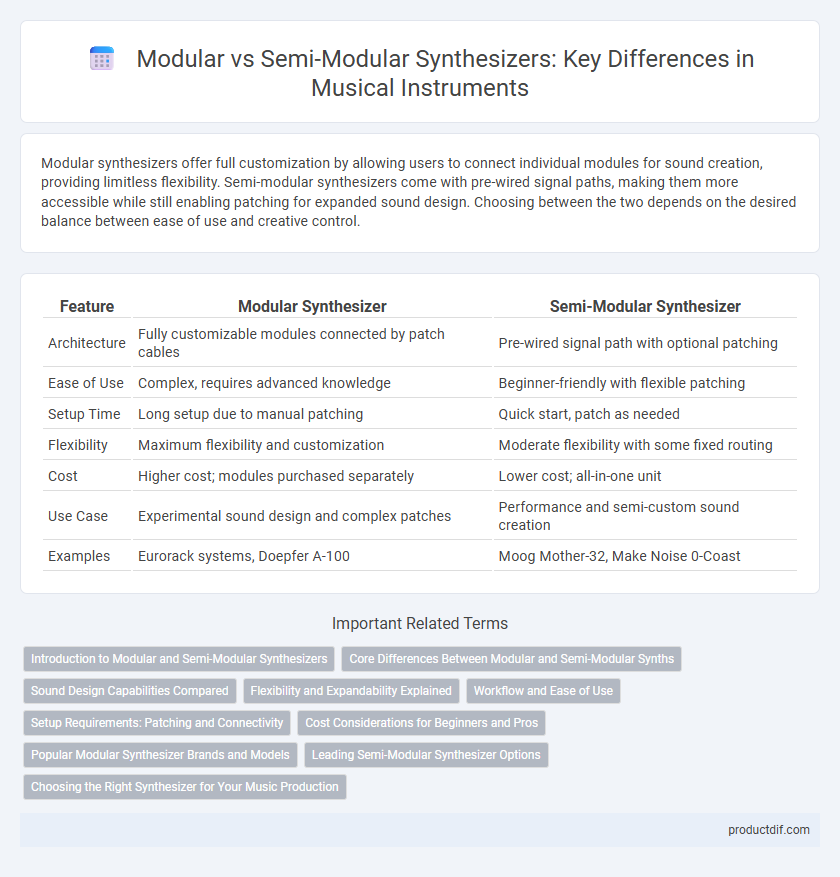Modular synthesizers offer full customization by allowing users to connect individual modules for sound creation, providing limitless flexibility. Semi-modular synthesizers come with pre-wired signal paths, making them more accessible while still enabling patching for expanded sound design. Choosing between the two depends on the desired balance between ease of use and creative control.
Table of Comparison
| Feature | Modular Synthesizer | Semi-Modular Synthesizer |
|---|---|---|
| Architecture | Fully customizable modules connected by patch cables | Pre-wired signal path with optional patching |
| Ease of Use | Complex, requires advanced knowledge | Beginner-friendly with flexible patching |
| Setup Time | Long setup due to manual patching | Quick start, patch as needed |
| Flexibility | Maximum flexibility and customization | Moderate flexibility with some fixed routing |
| Cost | Higher cost; modules purchased separately | Lower cost; all-in-one unit |
| Use Case | Experimental sound design and complex patches | Performance and semi-custom sound creation |
| Examples | Eurorack systems, Doepfer A-100 | Moog Mother-32, Make Noise 0-Coast |
Introduction to Modular and Semi-Modular Synthesizers
Modular synthesizers consist of separate, customizable modules connected via patch cables to create complex soundscapes, offering maximum flexibility and sound design potential. Semi-modular synthesizers feature pre-wired signal paths with patch points for added routing options, providing an accessible entry point into modular synthesis without requiring extensive patching. Both types enable rich sonic experimentation but cater to different skill levels and workflow preferences.
Core Differences Between Modular and Semi-Modular Synths
Modular synthesizers consist of individual modules like oscillators, filters, and amplifiers that require manual patching to create sound paths, offering complete flexibility but demanding in-depth knowledge and setup time. Semi-modular synthesizers feature a fixed internal signal path with pre-wired connections, allowing immediate sound generation while still supporting patching for customization. Core differences lie in the balance between user control and convenience, where modular synths provide total modularity and semi-modular synths deliver accessible experimentation with modular elements.
Sound Design Capabilities Compared
Modular synthesizers offer extensive sound design capabilities with fully customizable signal paths, allowing users to patch any module in complex ways for unique, evolving textures. Semi-modular synthesizers provide a balance between flexibility and ease of use, featuring pre-wired signal paths with additional patch points for partial customization. The modular approach excels in deep experimentation, while semi-modular units enable quicker sound creation with simplified, yet versatile, modulation options.
Flexibility and Expandability Explained
Modular synthesizers offer unparalleled flexibility and expandability by allowing users to connect and rearrange individual modules such as oscillators, filters, and envelopes in any configuration, enabling complete custom sound design. Semi-modular synthesizers provide a convenient middle ground with pre-wired signal paths for immediate playability, while still featuring patch points for customization and integration with other modules, making them more accessible yet expandable. The modular approach suits users seeking infinite tonal possibilities, whereas semi-modular units balance ease of use with moderate flexibility and growth potential.
Workflow and Ease of Use
Modular synthesizers offer maximum flexibility through fully customizable patching, allowing experienced users to design complex sound paths but requiring significant time and expertise. Semi-modular synthesizers feature pre-wired signal paths with optional patch points, providing an intuitive workflow that facilitates immediate playability while still enabling creative modulation. This combination makes semi-modular synths ideal for beginners and performers seeking rapid sound design without the extensive setup demanded by full modular systems.
Setup Requirements: Patching and Connectivity
Modular synthesizers require extensive manual patching to connect different modules, offering complete customization of signal flow and sound design but demanding in-depth knowledge and time for setup. Semi-modular synthesizers come with predefined internal connections, allowing immediate playability without patch cables, yet also provide patch points to override or expand the signal path for flexibility. The choice between them hinges on the user's preference for hands-on customization versus streamlined setup with modular capabilities.
Cost Considerations for Beginners and Pros
Modular synthesizers offer extensive customization but often demand a significant financial investment, making them less accessible for beginners due to high initial costs and ongoing expansion expenses. Semi-modular synthesizers provide a more budget-friendly alternative with pre-wired architecture and patching flexibility, appealing to novice musicians who want to explore sound design without the steep learning curve or expense. Experienced synth users might choose modular systems for ultimate control despite cost considerations, while semi-modular units balance affordability and versatility for both beginners and pros.
Popular Modular Synthesizer Brands and Models
Popular modular synthesizer brands include Moog, Make Noise, and Doepfer, known for their extensive Eurorack-compatible modules that allow full customization and patching flexibility. Semi-modular synthesizer models such as the Moog Mother-32, Make Noise 0-Coast, and Pittsburgh Modular Lifeforms offer integrated signal paths with patch points, combining hands-on playability and modular expandability. These instruments cater to artists seeking either complete modular freedom or streamlined semi-modular setups for versatile sound design.
Leading Semi-Modular Synthesizer Options
Leading semi-modular synthesizer options like the Moog Mother-32, Make Noise 0-Coast, and Pittsburgh Modular Lifeforms SV-1 offer versatile sound design capabilities without requiring full patching, making them accessible for both beginners and advanced users. These synths feature pre-wired signal paths combined with patch points, allowing users to explore modular synthesis while retaining immediate playability. Their integration of analog oscillators, filters, and modulation sources provides rich, dynamic tones essential for electronic music production.
Choosing the Right Synthesizer for Your Music Production
Selecting between a modular synthesizer and a semi-modular synthesizer depends on your workflow flexibility and sound design preferences. Modular synthesizers offer extensive customizability with fully patchable signal paths, ideal for experimental producers seeking complex, unique soundscapes. Semi-modular synthesizers provide immediate playability with pre-wired signal paths, allowing quick integration into existing setups while offering expansion options for gradual modular exploration.
Modular Synthesizer vs Semi-modular Synthesizer Infographic

 productdif.com
productdif.com